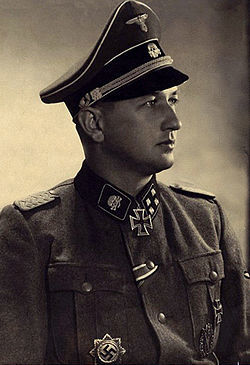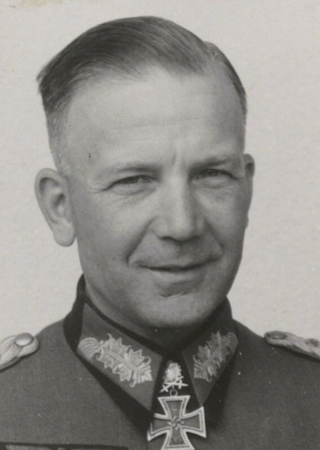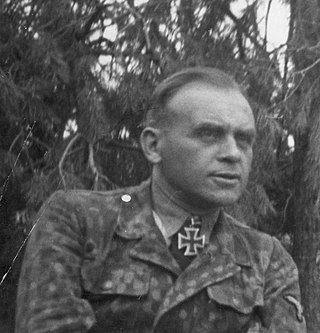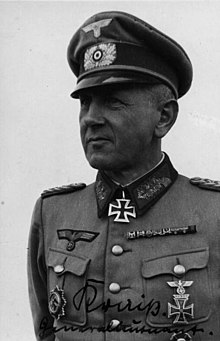
Erich Abraham was a general in the Wehrmacht of Nazi Germany who command the 76th Infantry Division then the LXIII Corps on the Western Front during World War II. He was also a recipient of the Knight's Cross of the Iron Cross with Oak Leaves.
Rudolf August Demme was a German General during World War II. He was also a recipient of the Knight's Cross of the Iron Cross with Oak Leaves, awarded by Nazi Germany for successful military leadership.

Otto Baum was a high-ranking commander (Oberführer) of the Waffen-SS during World War II. He was a recipient of the Knight's Cross of the Iron Cross with Oak Leaves and Swords of Nazi Germany.

Fritz-Hubert Gräser was a German general in the Wehrmacht of Nazi Germany. He was a recipient of the Knight's Cross of the Iron Cross with Oak Leaves and Swords.

Georg-Wilhelm Postel was a German general during World War II. He was a recipient of the Knight's Cross of the Iron Cross with Oak Leaves and Swords of Nazi Germany.

Hans Jordan was a German general during World War II. He was a recipient of the Knight's Cross of the Iron Cross with Oak Leaves and Swords of Nazi Germany.

Walter-Otto Weiß, also spelt Weiss, was a German general during World War II. In 1945 he became commander in chief of Army Group North on the Eastern Front. He was a recipient of the Knight's Cross of the Iron Cross with Oak Leaves.
Max Heinrich Sachsenheimer was a general in the German Army during World War II who commanded the 17th Infantry Division. He was a recipient of the Knight's Cross of the Iron Cross with Oak Leaves and Swords. On the 5th or 6th of February 1945, as part of the Vistula-Oder offensive in Dyhernfurth, he had made it possible for a commando operation to evacuate and destroy a special factory, which was probably a Tabun production plant for the Anorgana company.

Walter Fries was a German general in the Wehrmacht of Nazi Germany during World War II. He was a recipient of the Knight's Cross of the Iron Cross with Oak Leaves and Swords.
Helmut Dörner was a German commander in the Waffen-SS of Nazi Germany during World War II. He was a recipient of the Knight's Cross of the Iron Cross with Oak Leaves and Swords. During World War II, he was awarded both classes of the Iron Cross during the Battle of France. Dörner stayed with the Polizei division until late 1943, and was then transferred to Greece. When Karl Schümers was killed, Dörner took over the command until the arrival of the new commander. In September 1944 the 4th SS Polizei Division was sent to Rumania and Hungary. During the siege of Budapest, he became the commander of a mixed battle group and died during a breakthrough attempt.
Hermann Hohn was a German general in the Wehrmacht of Nazi Germany during World War II, who commanded several divisions. He was a recipient of the Knight's Cross of the Iron Cross with Oak Leaves and Swords.

Jürgen Wagner was a Brigadeführer in the Waffen-SS during World War II, the commander of the SS Division Nederland and was awarded the Knight's Cross of the Iron Cross with Oak Leaves.
General Sigfrid Henrici was a German general during World War II.

Maximilian Fretter-Pico was a German general during World War II. He was a recipient of the Knight's Cross of the Iron Cross with Oak Leaves of Nazi Germany.

Ernst-Eberhard Hell was a German general in the Wehrmacht during World War II. He commanded several divisions and later an army corps. He was a recipient of the Knight's Cross of the Iron Cross with Oak Leaves of Nazi Germany.
Friedrich Sixt was a German general during World War II who commanded several divisions. He was a recipient of the Knight's Cross of the Iron Cross with Oak Leaves of Nazi Germany.
Werner Hermann Karl Ebeling was an officer in the Wehrmacht of Nazi Germany during World War II and a general in the Bundeswehr of West Germany. He was a recipient of the Knight's Cross of the Iron Cross with Oak Leaves. He commanded the 11 Panzergrenadier Division of the Bundeswehr from 15 January 1968 to 30 September 1970.
Andreas Maria Karl von Aulock was a highly decorated Oberst in the Wehrmacht during World War II who commanded the 79th Infantry Division. He was a recipient of the Knight's Cross of the Iron Cross with Oak Leaves. The Knight's Cross of the Iron Cross and its higher grade Oak Leaves was awarded to recognise extreme battlefield bravery or successful military leadership.
Otto Schury was a German general during World War II. He was a recipient of the Knight's Cross of the Iron Cross with Oak Leaves of Nazi Germany.
Hans Schmidt was a German general during World War II. He was also a recipient of the Knight's Cross of the Iron Cross with Oak Leaves of Nazi Germany.










